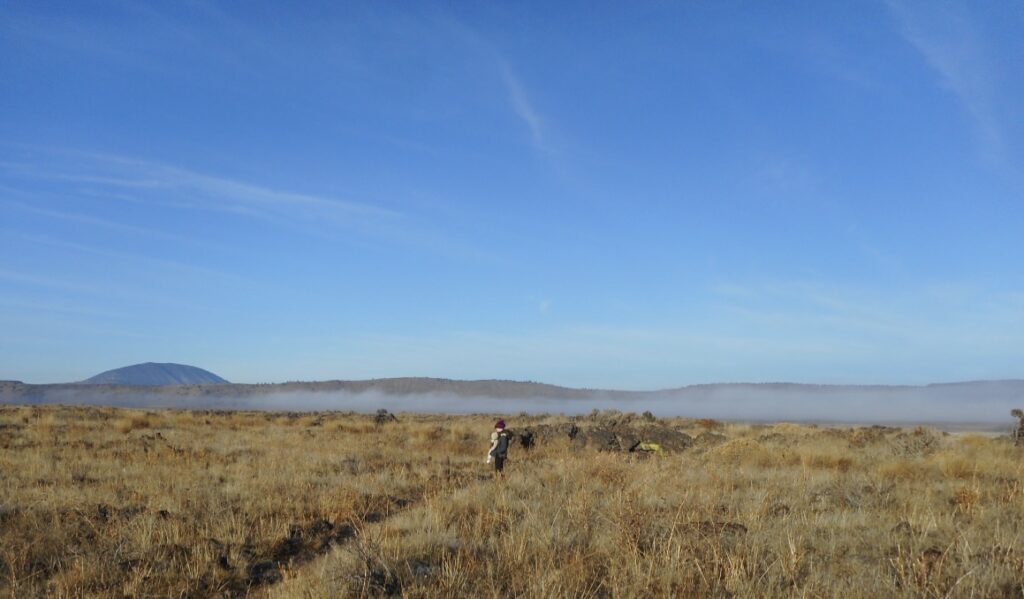This is Part 3 of a multi-part series.
Read Part 1 here.
Read Part 2 here.

III.
A wall drops away from the side of the trail, and the ground with it. The gaping hole in the earth is filled with brush—the collapse happened long ago. Peering down from the rim, I imagine tense Modoc faces gathered in discussion and preparation for what they must have known was coming next—retribution.
Following the death of General Canby, the US army prepared to attack the Modoc stronghold. They positioned themselves between Tule Lake and the tribe, cutting them off the from their main source of water. Over the next two days as the army added more troops and began to encircle the stronghold, the Modocs, recognizing their precarious position, quietly evacuated through the hidden folds in the land. When the army began their attack, they found the place deserted. The Modocs had escaped without detection.
Two weeks later, a band of warriors ambushed an army patrol and killed or wounded two thirds of the men before fleeing. It was a complete turn in fortune for the Modocs. They followed up with an attack at Dry Lake, but this time they were repelled decisively. In the retreat they lost many of their horses and vital supplies.
As my wife and I walk through the stronghold, we have passed by two more sunken cauldrons to a natural rise in the land. From here the plateau stretches for miles, unobstructed, southwest to a gleaming white Mt. Shasta and west toward a low brown ridge where the Modocs used to capture low-flying geese for food with nets made of tule reeds. To the northeast, farmland stretches for miles, interrupted only where the geology has upthrust the land and made irrigation impractical and development expensive. The hard lava we stand upon is among those interruptions, and it is hard to imagine that it would have become part of the national monument if it had been more fertile. Everything else is tilled under by the unforgiving machinery of colonial progress and westward expansion.
The rout at Dry Lake was so demoralizing and crippling to the Modocs war effort that the tribes split into factions and scattered. Army troops captured one of these factions, a group of Hot Creek Modocs, and in exchange for amnesty, four of them agreed to betray Captain Jack. On June 1st, he surrendered at Willow Creek. He was convicted of the murder of General Canby and hanged.
The remainder of the warring Modocs were exiled, loaded onto train cars and shipped away to Oklahoma like cattle. Disease, malnourishment, and an inability to adapt to the climate would kill nearly all of them. Present-day Oklahoma Modocs are descended from only seven survivors. The Modocs who had remained on the Klamath reservation during the wars were allowed to stay; they have since become included in federal recognition with the Klamath tribes.
At a junction in the trail, a wooden post stands erect, adorned with baseball caps, shoes, shirts, bandannas and feathers. It’s a mystery to me why it’s here, but it feels like a sort of memorial, an offering to the Modocs who stood their ground for so long against the encroachment of the colonizers. Was theirs a fool’s war? Looking across the criss-cut squares of alfalfa husks, it seems to me that some wars must be fought, even in the face of certain loss.
Homesteaders who traveled the Applegate trail and settled in this area were interested in one thing—cheap land for farming. It would be that same desire that would lead to the drainage of Tule Lake and other wetlands of the Klamath Basin, killing untold numbers of birds, fish, and other wildlife.
As my wife and I carry our now-sleeping daughter back to the car, these juxtapositions between opposites—hard lava and soft marsh, emigrants and natives, migrations and sanctuaries, ecology and civilization—play in my mind like a puzzle, each piece interconnected with all the others, nothing quite fitting right anymore, each potential solution creating a different set of problems.
And at the puzzle’s center—water.
to be continued…